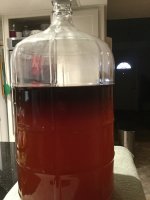I hope this is the right forum:
I was getting ready to bottle my latest batch and found it had done something I have never seen or heard about: there is a three-inch layer of beer at the top of the fermenter has a black tint.
It actually looks like a black and tan. It doesn’t taste like one. I sampled the clear black layer and the cloudy golden layer separately. Both have a sour taste and smell, more pronounced in the black layer.
Details:
This is a simple extract-based Kolsch recipe I’ve made successfully at four times this year. About 6 pounds of Pilsen Light DME with about 2 pounds milled grain (Wheat, Victory & Pils).
Steeped milled grains for 20 mins 3-gals water.
Then brought to a boil and added DME. Boiled for an hour adding hops along the way.
Moved to primary fermenter and added 2 gals of cold water. Added yeast.
Fermented two weeks in cool dark room until fermenting definitely stopped.
Transferred to carboy and moved to a large ice cooler to cold crash & clarify for 3 days. Added gelatin on second day.
Original SG 1.042, final 1.005
I sanitized everything properly as far as I can tell.
My notes reminded that I had a temperature issue while steeping the grains. It hit a high around 180F for a bit but I brought it back down to 160F. That is the only thing I can think of that seems wrong or bad.
Otherwise, I am assuming some sort of contamination.
I’ll have to write this one off but trying to figure out what exactly happened.
Any feedback appreciated.

I was getting ready to bottle my latest batch and found it had done something I have never seen or heard about: there is a three-inch layer of beer at the top of the fermenter has a black tint.
It actually looks like a black and tan. It doesn’t taste like one. I sampled the clear black layer and the cloudy golden layer separately. Both have a sour taste and smell, more pronounced in the black layer.
Details:
This is a simple extract-based Kolsch recipe I’ve made successfully at four times this year. About 6 pounds of Pilsen Light DME with about 2 pounds milled grain (Wheat, Victory & Pils).
Steeped milled grains for 20 mins 3-gals water.
Then brought to a boil and added DME. Boiled for an hour adding hops along the way.
Moved to primary fermenter and added 2 gals of cold water. Added yeast.
Fermented two weeks in cool dark room until fermenting definitely stopped.
Transferred to carboy and moved to a large ice cooler to cold crash & clarify for 3 days. Added gelatin on second day.
Original SG 1.042, final 1.005
I sanitized everything properly as far as I can tell.
My notes reminded that I had a temperature issue while steeping the grains. It hit a high around 180F for a bit but I brought it back down to 160F. That is the only thing I can think of that seems wrong or bad.
Otherwise, I am assuming some sort of contamination.
I’ll have to write this one off but trying to figure out what exactly happened.
Any feedback appreciated.





